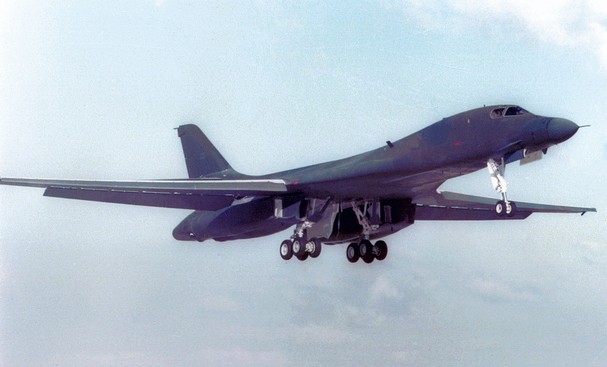
7 July 1985: The Strategic Air Command received the first operational Rockwell B-1B Lancer, serial number 83-0065, Star of Abilene, at Dyess Air Force Base, Abilene, Texas. It flew for 17 years, 7 months, 23 days before being retired 1 March 2003 and preserved at Dyess.

The B-1B is powered by four General Electric F101-GE-102 afterburning turbofan engines. This is an axial-flow engine with a 2-stage fan section, 9-stage compressor and 3-stage turbine (1 high- and 2 low-pressure stages). It is rated at 17,390 pounds of thrust (77.35 kilonewtons), and 30,780 pounds of thrust (136.92 kilonewtons) with afterburner. The F101-GE-102 is 15 feet, 0.7 inches (4.590 meters) long, 4 feet, 7.2 inches (1.402 meters) in diameter, and weighs 4,460 pounds (2,023 kilograms).

The B-1B has a maximum speed of Mach 1.25 (830 miles per hour (1,336 kilometers per hour) at high altitude, or 0.92 Mach (700 miles per hour, 1,127 kilometers per hour) at 200 feet (61 meters). The Lancer has a service ceiling of 60,000 feet (18,288 meters), and an unrefueled range of 7,456 miles (11,999 kilometers).
It can carry up to 84 Mk.82 500-pound bombs, 24 Mk.84 2,000-pound bombs, or other weapons.
100 B-1B Lancers were built by Rockwell International’s aircraft division at Air Force Plant 42, Palmdale, California, between 1983 and 1988. As of February 2018, 62 B-1B bombers are in the active Air Force inventory.

© 2018, Bryan R. Swopes
Thank you for this Bryan. Now why wasn’t the B-1B available for Desert Storm in 1991?
As I recall, the B-1B fleet was held back as a strategic deterrent.
The real reason it wasn’t used in the Gulf war is because of its poor operational readiness. I don’t think most people are aware of just how pathetically bad this aircraft really is.
You can count on the old B-52, but not this subpar lemon. Sorry, but that’s just a fact.
B-1A was capable of Mach 2. The B-1B dispensed with the variable geometry inlets and suffered a huge weight gain that rendered it only trans-sonic.
Indeed. The original variable geometry inlets allowed for Mach 2+ speeds. The inlets were changed with the B-1B to a serpentine baffle style that are fixed but hide the engine fan face. This limits the top speed but significantly reduces the radar signature when viewed from the forward aspect. This was a substantial improvement to the B-1’s radar signature, but the baffles have proven to be problematic for other operational reasons. The B version is heavier than the A, but that’s not what reduced the top speed limit.